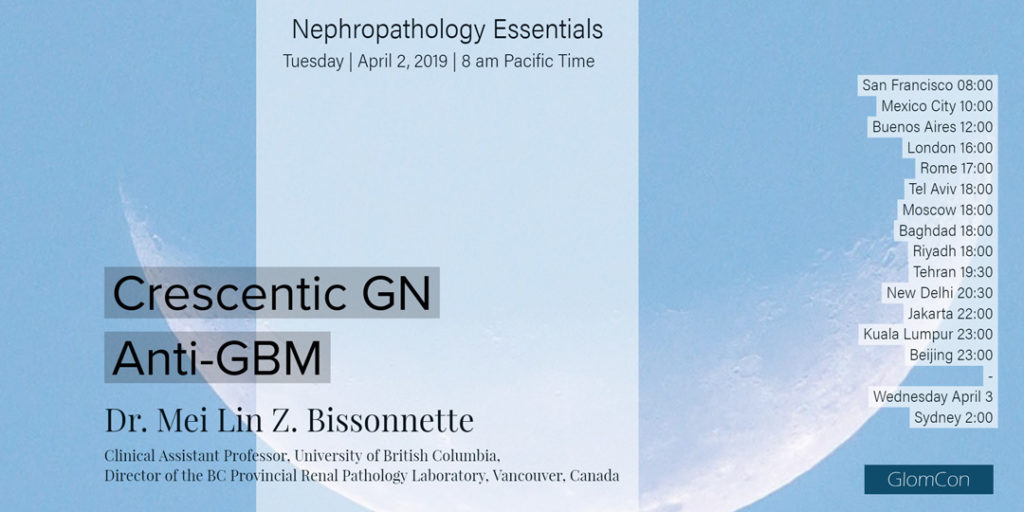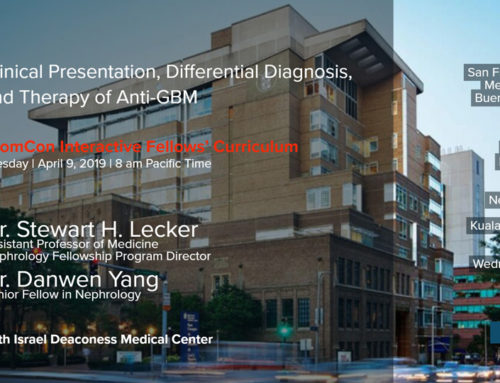NEPHROPATHOLOGY
Crescentic Glomerulonephritis and Anti-GBM Disease
In this GlomCon Conference, Dr. Bissonnette shared her expertise with us and reviewed the pathology of crescentic glomerulonephritis and anti-GBM disease. Our Moderator’s Notes are derived from her live presentation.


By Dr. Jessica Lapasia
Nephrologist
The Permanente Medical Group
Key points:
- Rapidly Progressive Glomerulonephritis is the clinical term for clinical manifestations that suggest severe GN including rapid rise in serum creatinine and onset of nephritic syndrome, often with diffuse crescent formation on biopsy.
- Immune Complex glomerulonephritis
IgA nephropathy, lupus nephritis, others - Pauci-immune glomerulonephritis
ANCA (MPO+/PR3+) - Anti-glomerular basement membrane glomerulonephritis (anti-GBM)
Classic, atypical
- Crescent formation
- Characterized by two or more layers of cells partially filling Bowman’s space, often macrophages and epithelial cells.
- Associated with breaks in the glomerular basement membrane and Bowman’s capsule that then allow inflammatory cells, cytokines enter.
- Cellular crescents often with fibrinoid necrosis (high degree of activity) evolve into fibrocellular and fibrous crescents. (signifying chronicity)
- Focal < 50% glomeruli with crescents vs Diffuse >50% glomeruli with crescents.
- Anti-GBM disease
- General characteristics
- Small vessel vasculitis affecting glomerular and/or pulmonary capillaries.
- Characterized by presence of circulating and deposited antibodies to basement membranes.
- 80-90% of patients present with RPGN, 40-60% with pulmonary hemorrhage.
- Comprises 15% of all diffusely crescentic GNs.
- Incidence of approximately 1 in 1,000,000.
- Equal male and female predominance.
- Bimodal age of onset: older children/young adults (peak 3rd decade) and older adults. (peak 6th-7th decades)
- Goodpasture syndrome: anti-GBM antibodies + pulmonary-renal syndrome.
- Anti-GBM glomerulonephritis: anti-GBM antibodies + renal involvement alone.
- Can also have anti-GBM antibodies + pulmonary involvement alone.
-
- Pathophysiology
- Likely involvement of several factors: pathologic antibody +/- environmental triggers (such as cigarette smoke, hydrocarbons, certain novel monoclonal antibody treatments) +/- a genetic association. (80% with HLA-DR2)
- Environmental insult + genetic susceptibility leads to breakage of hexamers in the non-collagenous region and exposure of EA/EB epitopes.
- Exposure of epitopes leads to autoantibodies to this non-collagenous region (a3(IV)NC1) which are then pathologic; also with complement fixation and inflammatory reaction. All of this leads to disruption of GBM and Bowman’s capsule and crescent formation.
- Classic anti-GBM disease
- IF shows linear IgG deposition along the GBM (brighter than background albumin staining), often also with C3 and kappa+lambda light chain staining along GBM; fibrinogen staining can help highlight areas of fibrinoid necrosis, fibrin, fibrinogen in the crescents.
- Typical to see large diffuse cellular crescents, similar phase of acuity.
- Outside glomeruli, often with interstitial inflammation and edema and can see red cell casts.
- Uninvolved glomeruli are unremarkable.
- Treatment may include PLEX, cyclophosphamide, corticosteroids, depending on the case
- Predictors of poor outcome: severity of renal function/dialysis dependence at presentation, percentage of glomeruli with crescents.
- Very low risk of recurrence.
- Atypical “anti-GBM disease”
- Renal-limited, with mild renal insufficiency, proteinuria, hematuria. (not RPGN)
- Negative for anti-GBM antibodies.
- Biopsy diagnosis: see strong linear IgG GBM staining with or without focal crescents.
- Glomeruli that do not have crescent involvement often have a proliferative pattern: endocapillary proliferation, mesangioproliferative or membranoproliferative.
- ELISA tests have high sensitivity/specificity to IgGs targeting EA and E.B epitopes; however, they tend to be less sensitive for other antibodies or epitopes (IgG4, IgA, IgM, alpha-4, alpha-5) and test may be false-negative. More sensitive testing with indirect IF can be helpful. Western blot is more sensitive but not widely available.
- Differential diagnosis for linear IgG staining
- Monotypic light chain staining. (such as in light chain deposition disease, heavy chain deposition disease with IgG staining in GBM, tubular basement membrane and vessels)
- Can get thickening of BM with diabetic nephropathy, smoking; typically show dull linear staining of GBM / tubular basement membrane.
- Membranous with ‘pseudolinear staining’.
- Focally active anti-GBM disease
- Positive circulating anti-GBM antibodies with preserved renal function.
- Linear IgG GBM staining with focal crescent formation and can see evidence of acute tubular injury.
- Dual positive anti-GBM disease plus ANCA
- Clinically resembles anti-GBM at presentation.
- Glomerular histology often resembles ANCA-associated vasculitis.
- All have linear IgG GBM staining; crescents may be at different stages, (cellular vs fibrocellular vs fibrous) which is similar to ANCA.
- More likely to relapse than classic anti-GBM disease.
Selected References:
https://www.ncbi.nlm.nih.gov/pubmed/29162595
https://www.ncbi.nlm.nih.gov/pubmed/26994577
https://www.ncbi.nlm.nih.gov/pubmed/28506760
- Pathophysiology


how to watch the presentation?